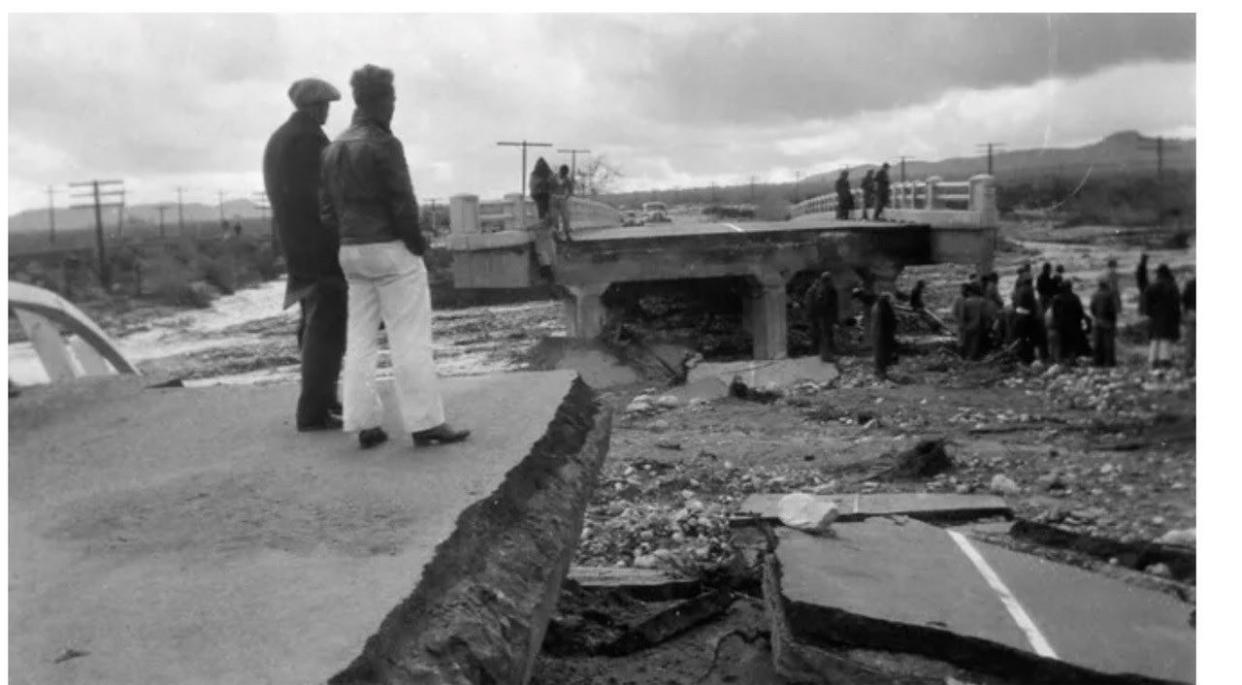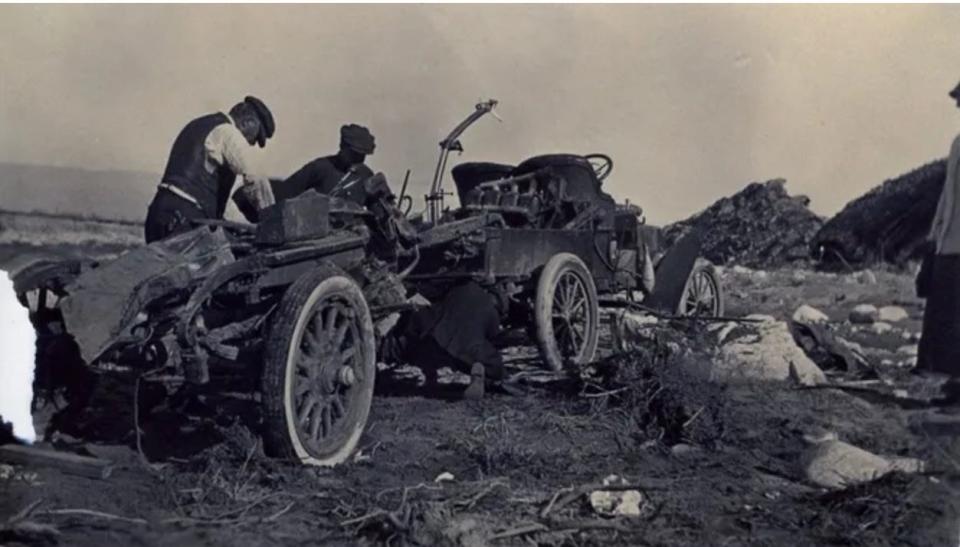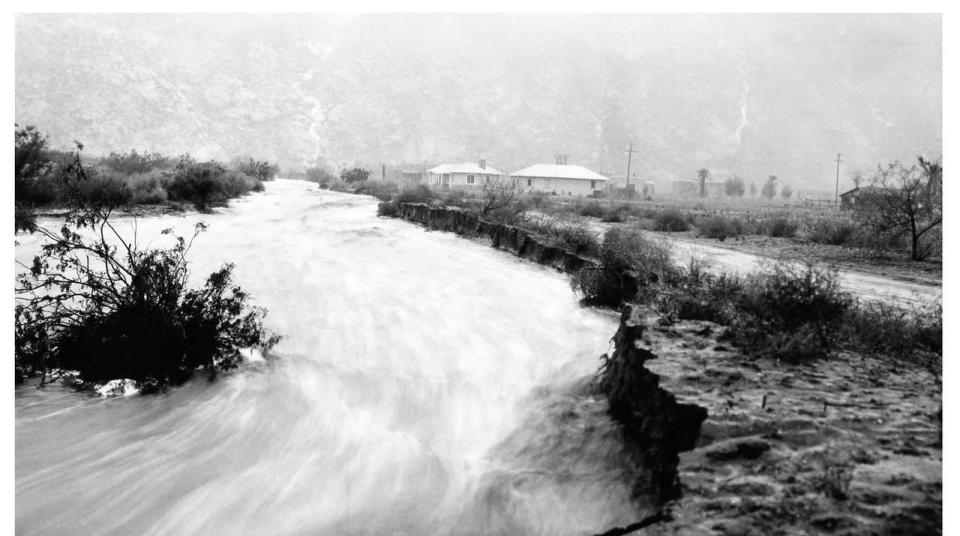History: Stormy weather in the dry desert over the decades

Weather in the desert seems mostly a dry subject. The usual history of Palm Springs mostly starts in a dry spell at the end of the 19th century when the little sprouting village planted by John McCallum at the base of Mt. San Jacinto desiccated and nearly perished despite all his efforts to bring water from Tahquitz Canyon and Whitewater via extensive flumes.
The drought lasted some 11 years when the aptly named Weather Bureau noted in 1901 a dying tropical cyclone brought “two inches of rain to the mountains and deserts of Southern California” ending the dry spell that nearly ended Palm Springs itself.
In the desert, when it finally rains, many times, it pours. But perhaps the most famous and influential deluge in the history of the Coachella Valley didn’t occur here at all. In 1905, heavy rainfall in the Colorado River basin caused the river to swell and eventually breach a foolishly naïve Imperial Valley irrigation dike. It took more than two years and a unprecedented engineering project to control the flow of the mighty Colorado into the Salton sink creating the inland sea.
Every decade of the 20th century then saw a terrific storm or so. In 1916 it rained so hard a tire from a car was washed clear from Palm Springs to Indio, and Main Street, (Palm Canyon Drive) itself was obliterated.

The next major flooding occurred in February 1927 when Snow Creek recorded 7 inches of rain in one day causing unprecedented flow of the Whitewater River. Floods washed out roads and bridges in Thousand Palms and Palm Desert. Levees were broken and Thermal was inundated with water.
Lime street, now Baristo, was a veritable river causing pioneer and owner of the local movie theater Earl Strebe to declare floods a reason to eschew buying any real estate in the “south end” of town. Baristo is paved in concrete, the only street in Palm Springs that is, and features curbs that are some 2 feet tall as it is actually a storm channel.

“El Cordonazo” or “The Lash of St. Francis” tropical storm (the convention of alternating first names following the letters of the alphabet wasn’t established until yet) hit Southern California in September of 1939 causing the greatest amount of September rainfall yet recorded. It lost hurricane status shortly before moving on shore as a tropical storm. There were torrential rains with nearly 7 inches of rain recorded at Indio in a mere six hours. The storm left the eastern Coachella Valley under 2 inches of water. This storm caused the Weather Bureau to establish a Forecast Office for Southern California, beginning operations in February 1940.
It also caused the Limelighter News to note that Flood Control Bids were sought, “advertised this week by the city on a project to improve the school corner at Granvia Valmonte where flood waters from Tacheva (sic) Falls run riot during heavy rains. A concrete retaining wall will be built against the school property with adequate provisions for heavy water.”
The 1940s featured multiple savage storms and in a heavy thunderstorm in 1946 it was reported that a house in Twentynine Palms was destroyed by a wall of water, carrying the garage and car in it half a mile away.
The government still catalogs interesting weather events. The table of contents to its Southern California report updated in 2017 reads like haiku:
Heavy Rain: Flooding and Flash Flooding, Mud Slides, Debris Flows, Landslides…Severe Thunderstorms: Large Hail, Strong Thunderstorm Winds, and Killer Lightning… Tornadoes, Funnel Clouds, Waterspouts, and Damaging Dust Devils...Strong winds...Extreme Heat... Extreme Cold.... High Surf, Stormy Seas, Tsunamis, Coastal Flooding and Erosion...Miscellaneous: Dense fog, barometric pressure, dry spells, Etc.
A new chapter in the history of heavy rainfall led to destruction through the Coachella Valley on Valentine's Day in 2019. Biblically heavy rain led to closures and water rescues across the Coachella Valley with 3.69 inches of rain falling at Palm Springs International Airport making it the wettest day recorded. The rain from Hurricane Hilary last week fell just shy of that record and left parts Cathedral City drowning in mud. History repeating itself.
One definition of the desert is prolonged dry spells. Dry spells, apparently sometimes punctuated by extremely stormy weather.
This article originally appeared on Palm Springs Desert Sun: Palm Springs history: Stormy weather in the dry desert over the years

